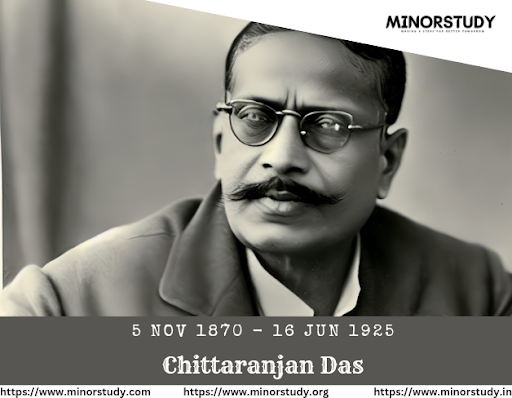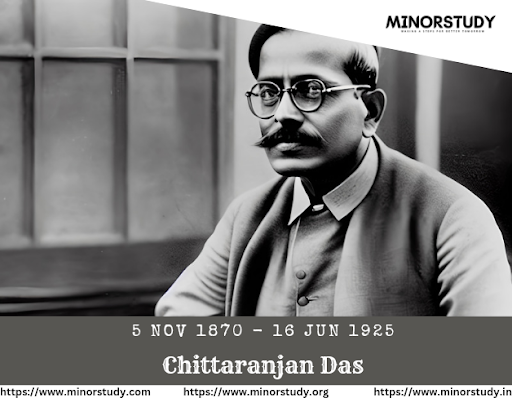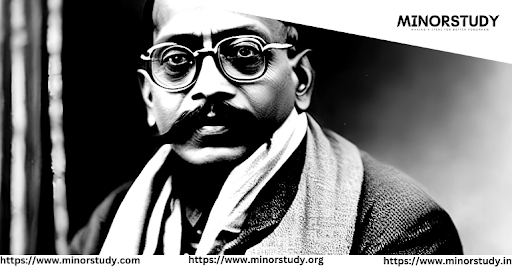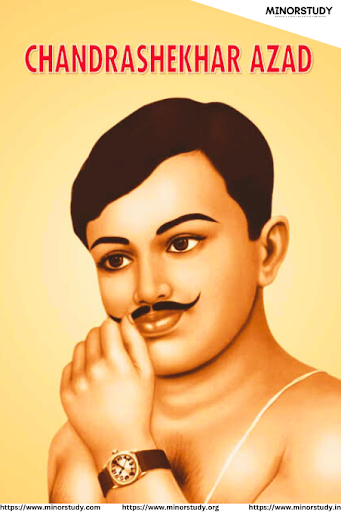for better tomorrow. Building India's & world's largest Education community. For correction, credit & Removal email us:- teamminorstudy@gmail.com
Chittaranjan Das, or C.R. Das, was a lawyer by trade, but he went on to play a very important part in the Indian struggle for independence from the British.
One of the first global initiatives to conserve and protect the earth is Earth Day, which is now an annual event that aims to bring about positive change on a global scale.
Indian freedom fighter Chandrashekhar Azad was a great man.
Lal Bahadur Shastri: Biography, fact and significance of the Indian History.
Do you know? On October 31, 1875, Vallabhbhai Patel was born in Nadiad, a small Gujarati village.
Poetry has the power to alter perceptions of the world, inspire others, strengthen interpersonal ties, and foster harmony among people.
Poetry has the power to alter perceptions of the world, inspire others, strengthen interpersonal ties, and foster harmony among people.
However, in a world filled with technology and more advanced means of communicating messages of beauty and art, poetry can be seen by many as a dying art form.
World Poetry Day aims to promote appreciation for the feelings that poetry can evoke, foster meaningful relationships, and broaden one's understanding of history and cultures.
Learn about World Poetry Day: World Poetry Day is an annual event that aims to promote the teaching, writing, publishing, and reading of poetry all over the world. In 1999, UNESCO declared it, stating that the purpose of establishing this day was as follows:
They also stated in their initial declaration that World Poetry Day was about giving international, regional, and national poetry movements fresh impetus and recognition. "with the aim of supporting linguistic diversity through poetic expression and increasing the opportunity for endangered languages to be heard."
Overall, this day aims to educate and motivate people while also recognizing the creative genius of poets from all over the world!
The origins of World Poetry Day can be traced back to the 30th General Conference, which took place in Paris in 1999. The attendees of the conference had the goal of raising awareness of endangered and dying cultures so that they could be heard and supporting the expansion of linguistic diversity through poetry.
World Poetry Day also pays tribute to poets, revives poetry recitals, and promotes poetry as an art form that helps people connect with their humanity. Poetry can provide insight into the thoughts and emotions of a particular era because it has a wide range of poets and periods to choose from.
People can also experience emotional bonds with others and experience the languages through which words and emotions are spoken by attending poetry recitals.
The United Nations Educational, Scientific, and Cultural Organization, a division of the United Nations that works to advance culture through hard work, enthusiasm, and communication, is hosting World Poetry Day.
Every year, schools, organizations, libraries, and publishers all over the world celebrate World Poetry Day by teaching about poets, styles of poetry, and the languages in which they are read.
People hold festivals, talk about their favorite poets, and learn about the various ways poetry can be written and spoken throughout the day. In addition, UNESCO provides social media kits and other resources to assist individuals all over the world in learning how to read poetry and comprehend its significance in everyday life.
How to Celebrate World Poetry Day Read some poetry to commemorate World Poetry Day. Look up poets like Ezra Pound, William Wordsworth, Sylvia Plath, and John Keats. Attend a college poetry class or a spoken word event to catch up on the most recent poets on stage if you want to learn more about poets out there.
World Poetry Day can be celebrated in a variety of exciting new ways. Why not watch a poetry reading instead of reading a poem? We now have access to a wide variety of videos thanks to sites like YouTube, so it should not be difficult to locate a poetry reading that piques your interest. The performance of a poem live, especially by the author who wrote it, is very powerful. It elevates the words' meaning to an entirely new level. Readings by authors like Jay Bernard and Hera Lindsay Bird are highly recommended. They are pretty amazing!
World Poetry Day is the ideal opportunity for you to educate your children about poetry and demonstrate how entertaining and exciting it can be. Besides, not every poem is serious! Sonnets can make us giggle, particularly those that utilization cunning pleasantry and plays on words.
There are numerous excellent books of poems written especially for children. We suggest Roger McGough's Poetry Pie, which includes more than fifty funny poems for kids. Cat Among the Pigeons by Kit Wright and Gargling with Jelly by Brian Patten are two other good choices.
Write your own poem if World Poetry Day has given you new ideas. Poetry writing doesn't require you to be Shakespeare! It is entirely up to you whether you want to share your poems with others or keep them to yourself. Don't worry if you're at a loss for words. If you've never written a poem before, it might seem a little overwhelming! Having a goal in mind at the outset is always beneficial. Why did you decide to write the poem in the first place?
Using images, similes, metaphors, and concrete words rather than abstract ones, communicating your theme, and avoiding sentimentality and cliches are some other types. You can learn more about writing poems by looking up some of the engaging books and videos that are available online. There is no right or wrong way to write a poem or begin the process; the only thing that matters is figuring out what works best for you. As a result, it can definitely be helpful to listen to some of the various approaches that people take.
Share the work of your favorite poet using the hashtag #WorldPoetryDay on social media. Inform your loved ones that today is a day to celebrate language and our ability to communicate with one another.
"How can I love you? Allow me to count the ways. This well-known poem was written by Elizabeth Barrett Browning for her husband Robert Browning. However, her well-known sonnet could just as easily declare her love for poetry itself. On March 21, which is World Poetry Day, we can all do that. This day was established in 1999 by the United Nations Educational, Scientific, and Cultural Organization (UNESCO).
Emotion and imagination are evoked by rhythms and imagery in poetry. Poetry can rhyme by employing meters, or long and short syllable poems. The style of poetry known as "free verse" doesn't always use rhyme or meters. Stanzas, which are like paragraphs in poetry, can have up to 12 lines in length. We think that the first poem ever written was written in Babylon 4,000 years ago. Today, endless kinds of sonnets are accessible to appreciate, including haikus, limericks, works, and melodies.
Facts about World Poetry Day: Poetry is a beautiful way to express yourself. The abstraction of poetry produces a greater variety of feelings and emotions than any other form of literature. Although the "Epic of Gilgamesh" is thought to have been the first work of poetry, it is likely that poetry existed long before literacy became widespread. Various kinds of verse have moved during various times, and gone through changes. The fundamental goal of poetry remains the same, regardless of whether it is expressed in sonnets or rap lyrics: to investigate the human condition and elicit emotion through language. Verse resounds with the existential situations of humanity, unearthing thoughts from profound inside.
On March 21 of each year, a linguistic expression with which people of all cultures can identify is the focus of World Poetry Day. Poetry brings people together based on shared values and humanity and can be found in every nation's history. The most fundamental of sonnets have the ability to mix discourse.
The day was proposed and embraced by UNESCO in 1999, on the event of its 30th General Meeting held in Paris to "give new acknowledgment and force to public, local and worldwide verse developments." Through this day, the organization hoped to promote poetic expression, preserve endangered languages, and encourage poetry celebration around the world. Oral poetry recitation traditions are revived, and poets of the past and present are honored. Poetry is encouraged to be read, written, and taught, and it is combined with other forms of expression like music, dance, painting, and more.
Important dates for World Poetry Day include the 18th century B.C. publication of the first book of poems. The "Epic of Gilgamesh" is one of the earliest known poems.
Sonnets Written in the 14th Century Francesco Petrarca's works are among the most well-known early "sonnets."
1999 At its 30th General Conference in Paris, An Ode to UNESCO declares March 21 to be World Poetry Day.
The First Celebration World Poetry Day is held on March 21, 2000.
Questions about World Poetry Day: How do we commemorate World Poetry Day?
Poetry festivals and events are held worldwide in honor of World Poetry Day, both online and off. Today, people also post about poetry and talk about their favorite poets. Social media kits and other resources for learning more about poetry are available from UNESCO.
When does National Poetry Day fall?
In the United Kingdom, National Poetry Day is observed on a Thursday in late September or early October.
Is April the Month of Poetry?
Yes, April is designated as National Poetry Month each year.
How to Celebrate World Poetry Day: Write a Poem There is no better way to celebrate and promote poetry than by writing your own. Try something small at first if you are unsure where to begin. A haiku is a straightforward three-line poem with five, seven, and five syllables in the middle. Haikus typically focus on nature and can be humorous or serious. Try your hand at free verse once you've mastered that. Perhaps a poem to your secret love?
Visit the American Poetry Museum in Washington, D.C. The American Poetry Museum is a building that celebrates poetry year-round. It was established in 2004 and is regarded as one of the pioneers in the field of poetry collection and presentation. In addition to special exhibits on the art form and famous poets, the museum hosts events and workshops for visitors to further their education.
Have a verse hammer
Get together your most scholarly companions for an evening of tomfoolery and rhymes. Make your living room into a coffee shop, and get ready to snap pictures of the performers. One of their own works or a favorite from another author can be read by friends. Prizes are not necessary (unless you want to compete!) — simply get together to celebrate poetry together.
Salman Rushdie once said, "A poet's work to name the unnameable, to point at frauds, to take sides, to start arguments, to shape the world, and stop it from going to sleep." These are some famous quotes about poetry.
"Poetry is a lot of joy, pain, and wonder, with a dash of the dictionary," according to Khalil Gibran.
"Always be a poet, even in prose," wrote Charles Baudelaire.
"Poets are shameless with their experiences:" Friedrich Nietzsche They make use of them.
"Poetry is the spontaneous overflow of powerful feelings," wrote William Wordsworth. It comes from a feeling that is remembered in peace.
The Importance of World Poetry Day: Poems are for everyone!
People sometimes hesitate to try poetry because they believe it can be difficult to comprehend. However, have no trepidation — there's a sonnet out there for you! Are you thinking about making your life easier and taking some time to unwind? Read Henry David Thoreau's writings. Do you want to read something about success and overcoming difficulties? Consider Maya Angelou. Do you need something a little silly to bring back memories of your youth? Take a look at Shel Silverstein: Be an early bird if you're a bird. Be that as it may, assuming that you're a worm, rest late."
Poetry is everywhere!
Are you a big music fan? Then you secretly enjoy poetry! Poetry's cadence and rhythms are similar to those of your favorite rap or pop song. Songs, like poetry, convey emotional messages and meanings with a few extra beats and melodies behind them. They even utilize a ton of similar composing gadgets like similitudes and similar sounding word usage.
It inspires a new generation of poetry lovers On World Poetry Day, educators and classrooms all over the world take time to honor poems and poets and inspire students to become interested in writing in a particular style. Poetry readings, competitions, and poetry slams are held to give new and upcoming poets a chance to try out their work and show off their skills!
What are our plans for World Poetry Day?
Poetry festivals and events are held worldwide in honor of World Poetry Day, both online and off. Individuals additionally post and discuss verse and their #1 artists today. Social media kits and other resources for learning more about poetry are available from UNESCO.
When does National Poetry Day fall?
In the United Kingdom, National Poetry Day is observed on a Thursday in late September or early October.
What are our plans for World Poetry Day? Poetry festivals and events are held worldwide in honor of World Poetry Day, both online and off. Today, people also post about poetry and talk about their favorite poets. Social media kits and other resources for learning more about poetry are available from UNESCO.
World Poetry Day is a worldwide celebration that takes place on March 21 each year. UNESCO established it. The point was to advance etymological variety and permit imperiled dialects to be heard. And what better way to accomplish this than through one of the most exquisite means of artistic expression: poetry?
Additionally, World Poetry Day encourages a dialogue between poetry and other forms of art and encourages the teaching, reading, writing, and publication of poetry. Its goal is to restore poetry's status as one of the most beloved and significant forms of art.
Quote from Robert Frost's poetry: The history of World Poetry Day In 1999, at the 30th General Conference in Paris, UNESCO declared March 21 to be World Poetry Day. World Poetry Day does not have a different theme each year, unlike other UN and UNESCO celebrations.
Around 2000 BCE, poetry appears to have been written down. Epic of Gilgamesh' is viewed as the most seasoned verse that started in Mesopotamia.
This day was before celebrated on October 15. This is due to the fact that Virgil, one of the greatest Roman poets, was born on this day. In fact, Poetry Day is still observed on November 15 in many nations. It is celebrated on the first Thursday of October in nations like the United Kingdom.
What is the purpose of World Poetry Day?
One of the oldest forms of literature and art known to men is poetry. It has always provided people with a means of expressing their humanity, identity, and self-expression. They were able to write about life, feelings, and thoughts thanks to poetry.
We can connect with others on a human level and find meaning in our experiences and existence by reading poetry. Poetry is essential for emotional growth in both children and adults. It may assist us in seeing things in a different light.
Poetry is a one-of-a-kind combination of language and form, like rhythm, meter, and symbolism, that lets writers better convey meaning and emotions than they can in other artistic forms. All of this is celebrated on World Poetry Day! Poetry transcends all linguistic limitations. As a result, it makes it possible for people to be heard and fosters multiculturalism and linguistic diversity.
UNESCO's goal is to connect people to their shared humanity by revitalizing the poetic oral tradition and encouraging poetry recitals. Poetry discusses universal experiences that many of us can identify with. Sonnets that were composed hundreds of years prior are as yet applicable today. Another beauty of poetry is that.
Also, World Poetry Day honors and celebrates all poets, past and present, with the intention of encouraging future generations to try their hand at poetry and preventing it from becoming a dying art form.
Famous American poets The United States has a long and illustrious literary tradition that continues to have a significant impact on other artistic fields. Many internationally acclaimed American poets have a voice that is uniquely American. Do you know any of the most well-known American poets listed here?
Whitman, Walt (1819–1922): One of the most significant works of American literature is his poem collection "Leaves of Grass."
Frost, Robert (1874–1963): Poetry writer Frost was awarded the Pulitzer Prize four times!
1830-1886: Emily Dickinson Perhaps of the most observed American artist, whose work tragically just earned respect after her demise.
T.S. Eliot, 1888–65: the poet who started the Modernist movement. The book "The Waste Land" is his.
Hughes, Langston (1901–1977): activist for civil rights and leader of the Harlem Renaissance.
Sylvia Plath (born in 1933–63): the founder of confessional poetry. She is the first person to win a Pulitzer Prize after passing away.
Poe, Edgar Allan (1809–1849): His three poems, "To Helen," "The Raven," and "Annabel Lee," made him famous.
1920-1994: Charles Bukowski Most popular for his sonnets portraying metropolitan life and the took advantage of segment of American culture.
Maya Angelou (b. 1951): Laureate of more than 54 prestigious honors. Her most well-known poem is "Still I Rise."
How to Celebrate World Poetry Day On World Poetry Day, government agencies, art groups, communities, schools, and libraries typically host readings, seminars, or lectures to honor poets and poetry. Check to see if there are any such events in your area to meet other poets.
Do you want more information about American poetry? If you live close to Washington, D.C., you should investigate some American poets and their works or, even better, visit the American Poetry Museum.
Why not give poetry writing a shot? It doesn't have to be shown to anyone, but it can be a great way to express your emotions.
Advance and backing verse by going to a verse presentation, or in any event, facilitating your own verse hammer, offering growing writers the chance to be heard!
RAVI RAZZ, CEO AND FOUNDER OF MINORSTUDY FOUNDATION
Dr. Manmohan Singh is a renowned Indian economist, academic, and politician who served as the 13th Prime Minister of India from ...

-
Dr. Manmohan Singh is a renowned Indian economist, academic, and politician who served as the 13th Prime Minister of India from ...
-
About Gaur Gopal Das: Gaur Gopal Das is a globally renowned spiritual leader, motivational speaker, and life coach, known for hi...
-
About Vivek Bindra: Vivek Bindra is an Indian entrepreneur, motivational speaker, and business coach. He is widely recognized fo...
-
Shailaputri is the girl of the Mountain Ruler Himavat, and is a sign and type of the Hindu mother goddess Mahadevi, addressing herself as th...
-
**Parumala Perunnal** is a significant annual Christian festival held in honor o...
-
**Date:** National Fish Farmers Day is celebrated annually on July 10 in India. **History:** - **Origins:** National Fish Farm...
-
The **International Day for Preventing the Exploitation of the Environment in War and Armed ...
-
**Date:** Cow Appreciation Day is celebrated annually on the second Tuesday of July. In 2024, it will be observed on July 9. *...
-
### International Day of Parliamentarism 2024: Date, Theme, History, and Significance **Date:** Internat...
-
### National Workaholics Day: Date, History, and Significance **Date:** National Workaholics Day is celebrated annually on July ...






































